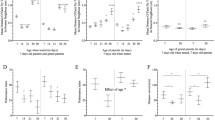Abstract
Drosophila melanogastermales initiated aggressive behavior toward other males and defended territories several hours after they were able to court and mate females. Males that were 3 days or more posteclosion were more successful at holding territories than younger males. Three-day-old males established territories more readily and escalated more often against territory residents than males that were 1 day old. Residents did not usually force young males from territories until they were a few hours posteclosion. The development of territorial behavior was not affected by familiarity or prior exposure to females. Males held in isolation established territories more quickly and behaved more aggressively than males held in groups. Males that previously held territories were more likely to reestablish them after a disturbance.
Similar content being viewed by others
References
Caro, T. M., and Bateson, P. (1986). Organization and ontogeny of alternative tactics.Anim. Behav. 34: 1483–1499.
Ellis, L. B., and Kessler, S. (1975). Differential posteclosion housing experiences and reproduction inDrosophila.Anim. Behav. 23: 949–952.
Hoffmann, A. A. (1987a). A laboratory study of male territoriality in the sibling speciesDrosophila melanogaster andD. simulans.Anim. Behav. 35: 807–818.
Hoffmann, A. A. (1987b). Territorial encounters betweenDrosophila males of different sizes.Anim. Behav. 35: 1899–1901.
Hoffmann, A. A. (1988). Heritable variation for territorial success in twoDrosophila melanogaster populations.Anim. Behav. 36: 1180–1189.
Hoffmann, A. A., and Cacoyianni, Z. (1989). Selection for territoriality inDrosophila melanogaster. Correlated responses in mating success and other fitness components.Anim. Behav. 38: 23–34.
Jacobs, M. E. (1960). Influence of light on mating ofDrosophila melanogaster.Ecology 41: 182–188.
Jallon, J.-M. (1984). A few chemical words exchanged byDrosophila during courtship and mating.Behav. Genet. 14: 441–478.
Jallon, J.-M., Antony, C., and Benemar, O. (1981). Un antiaphrodisiac produit par les mâles deDrosophila melanogaster et transferé aux femelles lors de la copulation.C.R. Acad. Sci. Paris 292: 1147–1149.
Knoppien, P. (1987). Rare-male advantage: An artifact caused by differential storage conditions?Behav. Genet. 17: 409–425.
Mane, S. D., Tompkins, L., and Richmond, R. C. (1983). Male esterase 6 catalyzes the synthesis of a sex pheromone inDrosophila melanogaster females.Science 222: 419–421.
Manning, A., and Johnstone, G. (1970). The effects of early adult experience on the development of aggressiveness in males of the cockroach,Nauphoeta cinerea.Rev. Comp. Animal 4: 12–16.
McRobert, S. P., and Tompkins, L. (1983). Courtship of young males is ubiquitous inDrosophila melanogaster.Behav. Genet. 13: 517–523.
Moore, A. J., Ciccone, W. J., and Breed, M. D. (1988). The influence of social experience on the behavior of male cockroaches,Nauphoeta cinerea.J. Insect Behav. 1: 157–168.
Rosewell, J., and Shorrocks, B. (1987). The implication of survival rates in natural populations ofDrosophila: Capture-recapture experiments on domestic species.Biol. J. Linn. Soc. 32: 373–384.
Skrzipek, K. H., Kroner, B., and Hager, H. (1979). Aggression beiDrosophila melanogaster — Laboruntersuchungen.Z. Tierpsychol. 49: 87–103.
Spieth, H. T. (1974). Courtship behavior in Drosophila.Annu. Rev. Entomol. 19: 385–405.
Tompkins, L. (1984). Genetic analysis of sex appealin Drosophila.Behav. Genet. 14: 411–440.
Waage, J. K. (1973). Reproductive behavior and its relation to territoriality inCalopteryx maculata (Beauvois) (Odontata: Calopterygidae).Behaviour 47: 240–256.
Author information
Authors and Affiliations
Rights and permissions
About this article
Cite this article
Hoffmann, A.A. The influence of age and experience with conspecifics on territorial behavior inDrosophila melanogaster . J Insect Behav 3, 1–12 (1990). https://doi.org/10.1007/BF01049191
Accepted:
Issue Date:
DOI: https://doi.org/10.1007/BF01049191




